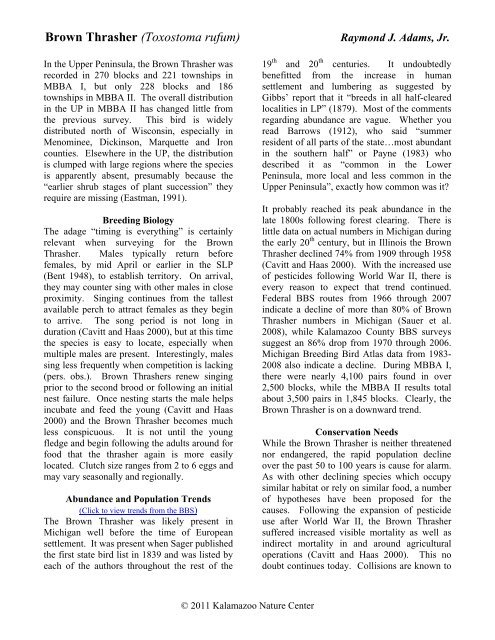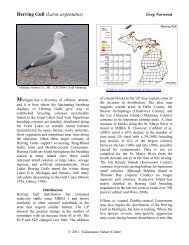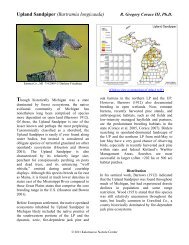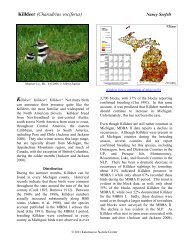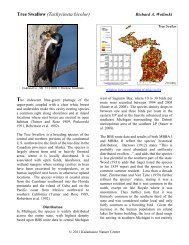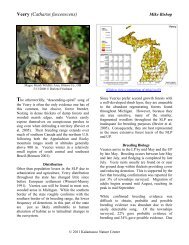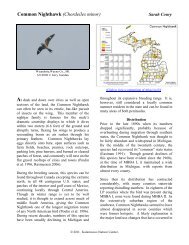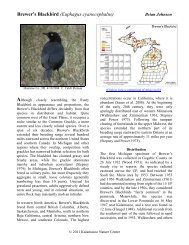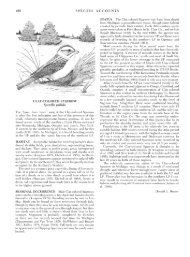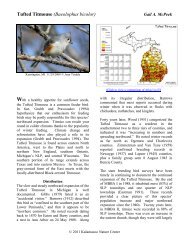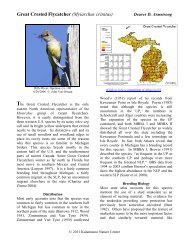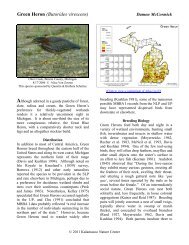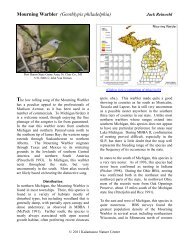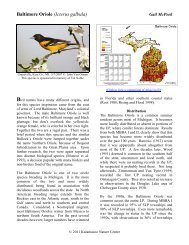Brown Thrasher - Michigan Breeding Bird Atlas Website
Brown Thrasher - Michigan Breeding Bird Atlas Website
Brown Thrasher - Michigan Breeding Bird Atlas Website
You also want an ePaper? Increase the reach of your titles
YUMPU automatically turns print PDFs into web optimized ePapers that Google loves.
<strong>Brown</strong> <strong>Thrasher</strong> (Toxostoma rufum)<br />
In the Upper Peninsula, the <strong>Brown</strong> <strong>Thrasher</strong> was<br />
recorded in 270 blocks and 221 townships in<br />
MBBA I, but only 228 blocks and 186<br />
townships in MBBA II. The overall distribution<br />
in the UP in MBBA II has changed little from<br />
the previous survey. This bird is widely<br />
distributed north of Wisconsin, especially in<br />
Menominee, Dickinson, Marquette and Iron<br />
counties. Elsewhere in the UP, the distribution<br />
is clumped with large regions where the species<br />
is apparently absent, presumably because the<br />
“earlier shrub stages of plant succession” they<br />
require are missing (Eastman, 1991).<br />
<strong>Breeding</strong> Biology<br />
The adage “timing is everything” is certainly<br />
relevant when surveying for the <strong>Brown</strong><br />
<strong>Thrasher</strong>. Males typically return before<br />
females, by mid April or earlier in the SLP<br />
(Bent 1948), to establish territory. On arrival,<br />
they may counter sing with other males in close<br />
proximity. Singing continues from the tallest<br />
available perch to attract females as they begin<br />
to arrive. The song period is not long in<br />
duration (Cavitt and Haas 2000), but at this time<br />
the species is easy to locate, especially when<br />
multiple males are present. Interestingly, males<br />
sing less frequently when competition is lacking<br />
(pers. obs.). <strong>Brown</strong> <strong>Thrasher</strong>s renew singing<br />
prior to the second brood or following an initial<br />
nest failure. Once nesting starts the male helps<br />
incubate and feed the young (Cavitt and Haas<br />
2000) and the <strong>Brown</strong> <strong>Thrasher</strong> becomes much<br />
less conspicuous. It is not until the young<br />
fledge and begin following the adults around for<br />
food that the thrasher again is more easily<br />
located. Clutch size ranges from 2 to 6 eggs and<br />
may vary seasonally and regionally.<br />
Abundance and Population Trends<br />
(Click to view trends from the BBS)<br />
The <strong>Brown</strong> <strong>Thrasher</strong> was likely present in<br />
<strong>Michigan</strong> well before the time of European<br />
settlement. It was present when Sager published<br />
the first state bird list in 1839 and was listed by<br />
each of the authors throughout the rest of the<br />
Raymond J. Adams, Jr.<br />
19 th and 20 th centuries. It undoubtedly<br />
benefitted from the increase in human<br />
settlement and lumbering as suggested by<br />
Gibbs’ report that it “breeds in all half-cleared<br />
localities in LP” (1879). Most of the comments<br />
regarding abundance are vague. Whether you<br />
read Barrows (1912), who said “summer<br />
resident of all parts of the state…most abundant<br />
in the southern half” or Payne (1983) who<br />
described it as “common in the Lower<br />
Peninsula, more local and less common in the<br />
Upper Peninsula”, exactly how common was it<br />
It probably reached its peak abundance in the<br />
late 1800s following forest clearing. There is<br />
little data on actual numbers in <strong>Michigan</strong> during<br />
the early 20 th century, but in Illinois the <strong>Brown</strong><br />
<strong>Thrasher</strong> declined 74% from 1909 through 1958<br />
(Cavitt and Haas 2000). With the increased use<br />
of pesticides following World War II, there is<br />
every reason to expect that trend continued.<br />
Federal BBS routes from 1966 through 2007<br />
indicate a decline of more than 80% of <strong>Brown</strong><br />
<strong>Thrasher</strong> numbers in <strong>Michigan</strong> (Sauer et al.<br />
2008), while Kalamazoo County BBS surveys<br />
suggest an 86% drop from 1970 through 2006.<br />
<strong>Michigan</strong> <strong>Breeding</strong> <strong>Bird</strong> <strong>Atlas</strong> data from 1983-<br />
2008 also indicate a decline. During MBBA I,<br />
there were nearly 4,100 pairs found in over<br />
2,500 blocks, while the MBBA II results total<br />
about 3,500 pairs in 1,845 blocks. Clearly, the<br />
<strong>Brown</strong> <strong>Thrasher</strong> is on a downward trend.<br />
Conservation Needs<br />
While the <strong>Brown</strong> <strong>Thrasher</strong> is neither threatened<br />
nor endangered, the rapid population decline<br />
over the past 50 to 100 years is cause for alarm.<br />
As with other declining species which occupy<br />
similar habitat or rely on similar food, a number<br />
of hypotheses have been proposed for the<br />
causes. Following the expansion of pesticide<br />
use after World War II, the <strong>Brown</strong> <strong>Thrasher</strong><br />
suffered increased visible mortality as well as<br />
indirect mortality in and around agricultural<br />
operations (Cavitt and Haas 2000). This no<br />
doubt continues today. Collisions are known to<br />
© 2011 Kalamazoo Nature Center


